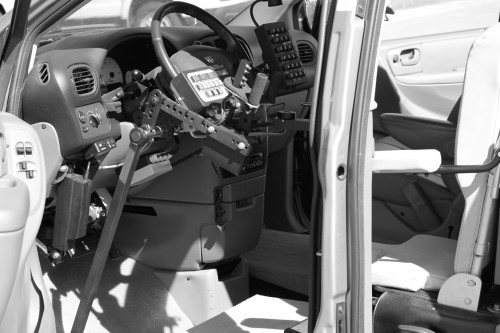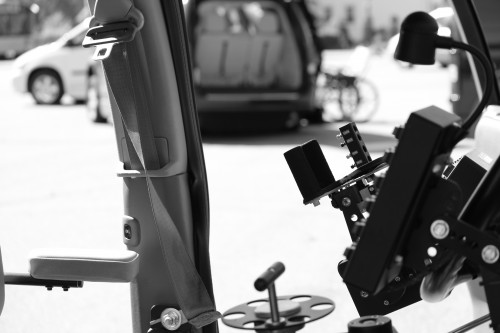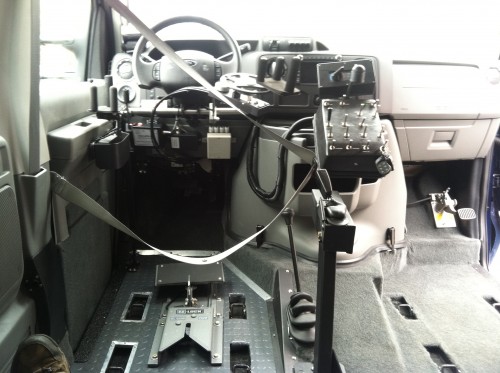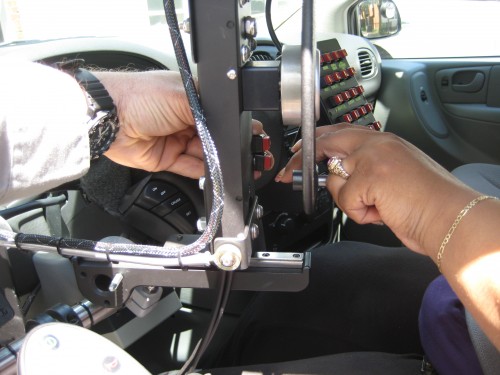Tag Archives: multiple sclerosis
mobility concept vehicles for wheelchair drivers
“To get something you never had, you have to do something you’ve never done.” ~Unknown


One definition of resilience is “the ability to cope with shocks and keep functioning in a satisfying way”. Resilience is about the self organizing capacity of systems. This means the ability to bounce back after disaster, or the ability to transform if a bad stage has happened. Both of these forms of resilience seem relevant to explore in our times, especially in relation to Assistive Driving Technology for Wheelchair Drivers.
Vmi New England and Automotive Innovations as a company is aware of this challenge and has been working on cutting edge wheelchair driving technology since the 80’s
automotive mobility concept vehicle systems
Vmi New England and Automotive Innovations is leading in its study of ever evolving automotive wheelchair driving systems.

Ford wheelchair driver and passenger concept vehicles
The way we see it, everyone has a fundamental need to have there own personal transportation, to access anything they need like, clean water, food, fibres and many other goods and services.
For future human development it is essential to understand the contribution each person can make to human livelihoods, health, security and culture if given the chance.

wheelchair driver and passenger concept vehicles
Resilience thinking is part of the solution, as it thrives at building flexibility and adaptive capacity. People and nature are interdependent. That means, we have to look for collaboration within society to find resilient solutions.
Interdependence between people and nature.

Exploring the missing links in our imagination
Solutions to find new possibilities in the Assistive Driving Technology require creativity.
Creativity is the answer to missing links in our imagination, at least according to Jim Sanders. They have found a unique way to explore the relationship between current automotive designs, people and technology.
A safe operating vehicle for people in wheelchairs
“In the face of ever evolving change in transportation needs, we need to work together to find safe mobility solutions for humanity. The key is in creative mobility solutions that connect nature with people. Flexible and adaptive strategies will bring us further. By stretching our imagination, we will start to explore the unknown. And by always looking for new combinations of technology, and common sense, we will find the new solutions.” Jim Sanders 2013
Sometimes even the smallest shift in thinking or doing can create the biggest changes in someones lifecan you save trust for a rainy day?necessity is the mother of invention

driven by the freedom of the choice to explore the worlds future possibilities
Multiple sclerosis: Causes, incidence, and risk factors
Multiple sclerosis
Causes, incidence, and risk factors
Symptoms
- Loss of balance
- Muscle spasms
- Numbness or abnormal sensation in any area
- Problems moving arms or legs
- Problems walking
- Problems with coordination and making small movements
- Tremor in one or more arms or legs
- Weakness in one or more arms or legs
- Constipation and stool leakage
- Difficulty beginning to urinate
- Frequent need to urinate
- Strong urge to urinate
- Urine leakage (incontinence)
- Double vision
- Eye discomfort
- Uncontrollable rapid eye movements
- Vision loss (usually affects one eye at a time)
- Facial pain
- Painful muscle spasms
- Tingling, crawling, or burning feeling in the arms and legs
- Decreased attention span, poor judgment, and memory loss
- Difficulty reasoning and solving problems
- Depression or feelings of sadness
- Dizziness and balance problems
- Hearing loss
- Problems with erections
- Problems with vaginal lubrication
- Slurred or difficult-to-understand speech
- Trouble chewing and swallowing
Signs and tests
- Abnormal nerve reflexes
- Decreased ability to move a part of the body
- Decreased or abnormal sensation
- Other loss of nervous system functions
- Abnormal pupil responses
- Changes in the visual fields or eye movements
- Decreased visual acuity
- Problems with the inside parts of the eye
- Rapid eye movements triggered when the eye moves
- Lumbar puncture (spinal tap) for cerebrospinal fluid tests, including CSF oligoclonal banding
- MRI scan of the brain and MRI scan of the spine are important to help diagnose and follow MS
- Nerve function study (evoked potential test)
Treatment
- Interferons (Avonex, Betaseron, or Rebif), glatiramer acetate (Copaxone), mitoxantrone (Novantrone), andnatalizumab (Tysabri)
- Fingolimod (Gilenya )
- Methotrexate, azathioprine (Imuran), intravenous immunoglobulin (IVIg) and cyclophosphamide (Cytoxan) may also be used if the above drugs are not working well
- Medicines to reduce muscle spasms such as Lioresal (Baclofen), tizanidine (Zanaflex), or a benzodiazepine
- Cholinergic medications to reduce urinary problems
- Antidepressants for mood or behavior symptoms
- Amantadine for fatigue
- Physical therapy, speech therapy, occupational therapy, and support groups
- Assistive devices, such as wheelchairs, bed lifts, shower chairs, walkers, and wall bars
- A planned exercise program early in the course of the disorder
- A healthy lifestyle, with good nutrition and enough rest and relaxation
- Avoiding fatigue, stress, temperature extremes, and illness
- Changes in what you eat or drink if there are swallowing problems
- Making changes around the home to prevent falls
- Social workers or other counseling services to help you cope with the disorder and get assistance (such as Meals-on-Wheels)
Support Groups
Expectations (prognosis)
- Females
- People who were young (less than 30 years) when the disease started
- People with infrequent attacks
- People with a relapsing-remitting pattern
- People who have limited disease on imaging studies
- How often you have attacks
- How severe they are
- The part of the central nervous system that is affected by each attack
Complications
- Depression
- Difficulty swallowing
- Difficulty thinking
- Less and less ability to care for self
- Need for indwelling catheter
- Osteoporosis or thinning of the bones
- Pressure sores
- Side effects of medications used to treat the disorder
- Urinary tract infections
Calling your health care provider
- You develop any symptoms of MS
- Symptoms get worse, even with treatment
- The condition deteriorates to the point where home care is no longer possible
References
- Calabresi P. Multiple sclerosis and demyelinating conditions of the central nervous system. In: Goldman L, Ausiello D, eds. Cecil Medicine. 23rd ed. Philadelphia, Pa: Saunders Elsevier;2007:chap 436.
- Carroll WM. Oral therapy for multiple sclerosis–sea change or incremental step? N Engl J Med. 2010 Feb 4;362(5):456-8. Epub 2010 Jan 20. [PubMed]
- Goodin DS, Cohen BA, O’Connor P, et al. Therapeutics and Technology Assessment Subcommittee of the American Academy of Neurology. Assessment: the use of natalizumab (Tysabri) for the treatment of multiple sclerosis (an evidence-based review): report of the Therapeutics and Technology Assessment Subcommittee of the American Academy of Neurology. Neurology. 2008:71(10):766-73. [PubMed]
- Farinotti M, Simi S, Di Pietrantonj C, McDowell N, Brait L, Lupo D, Filippini G. Dietary interventions for multiple sclerosis. Cochrane Database Syst Rev. 2007 Jan 24;(1):CD004192. [PubMed]
- Kappos L, Freedman MS, Polman CH, et al. Effect of early versus delayed interferon beta-1b treatment on disability after a first clinical event suggestive of multiple sclerosis: a 3-year follow-up analysis of the BENEFIT study. Lancet. 2007:370(9585):389-97. [PubMed]
- Miller DH, Leary SM. Primary-progressive multiple sclerosis. Lancet Neurol. 2007;6:903-912. [PubMed]
- Marriott JJ, Miyasaki JM, Gronseth G, O’Connor PW; Therapeutics and Technology Assessment Subcommittee of the American Academy of Neurology. Evidence Report: The efficacy and safety of mitoxantrone (Novantrone) in the treatment of multiple sclerosis: Report of the Therapeutics and Technology Assessment Subcommittee of the American Academy of Neurology. Neurology. 2010 May 4;74(18):1463-70. [PMC free article] [PubMed]
Multiple Sclerosis
Multiple Sclerosis can affect individuals in varying ways including tingling, numbness, slurred speech, blurred or double vision, muscle weakness, poor coordination, unusual fatigue, muscle cramps, bowel and bladder problems and paralysis. Due to these symptoms, special equipment or accommodations may need to be made to aid a person in safely maintaining their mobility independence for as long as possible.
Physical Considerations: The following are considerations for selecting a vehicle:
Driving a sedan: The Individual must be able to do the following:
- Open and close the Door
- Transfer in and out of the vehicle
- A wheelchair/scooter must be able to be stored and retrieved. Special equipment is available to aid with storage.
Driving a Van: Options may include a mini-van with a lowered floor and a ramp or a full size van with a lift. Specialized modifications allow a person to transfer to the driver’s seat or drive from a wheelchair. Technology may be able to compensate for the loss of strength or range of motion such as:
- Reduced effort steering and/or brake systems to compensate for reduced strength.
- Mechanical hand controls allow for operation of the gas and brake using upper extremities.
- Servo brake/ accelerator systems compensate for reduced strength/range of motion of arms.
- If spasticity is difficult to manage, it may lead to an inability to drive.
Visual Changes:
- May be severe enough that driving is precluded or night driving is prohibited.
- If double vision is intermittent and can be monitored independently, then driving may be limited to avoid driving during an exacerbation.
- Sunglasses may help with glare sensitivity.
- Compensate for loss of peripheral vision with special mirrors and head turning.
- Learn order of traffic signals to aid with color vision impairment.
Cognitive Issues:
- Need to regulate emotions and avoid driving when upset, angry or overly emotional.
- May be limited to familiar routes if some loss of memory or problem solving but still enough judgment to drive.
Decreased Energy:
- Energy conservation is vital.
- May require assistance with wheelchair loading to save energy for driving.
- Air conditioning aids with managing warm climates.
Medications:
- Seek the physician’s input regarding side effects which may impair driving.
- Monitor when medications are taken. Don’t drive when sleepy or just before or after medicating
If you or those that drive with you notice any of the above warning signs and need a driving evaluation, give us a call at 508-697-6006 and we can, help you with with knowledge about medical conditions, and help with a comprehensive evaluation and determine your ability to drive.
- Visual Perception
- Functional Ability
- Reaction Time
- Behind-the-wheel evaluation

